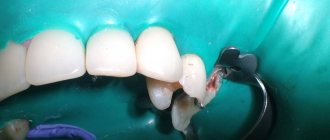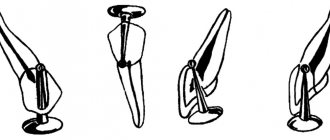For almost everyone, dental treatment is a kind of test. There are risks of developing complications after an incorrectly installed filling or a poorly extracted tooth. There is also the possibility of undesirable consequences from the anesthetic injection. Local anesthesia is almost always used: treatment of deep carious cavities, pulpitis, periodontitis, tooth extraction, prosthetics, implantation, etc. If numbness after an injection does not go away for quite a long time, you need to identify the causes and find ways to eliminate the disease.
How long does it take for a painkiller injection to wear off?
Dentists use several types of anesthesia:
- Applique. An anesthetic in the form of a gel or ointment is applied to the desired area of the gum.
- Conductor. Administered by injection.
- Infiltration. Three-stage anesthesia is usually performed before complex manipulations.
After treatment or tooth extraction, depending on the type of anesthesia, a feeling of numbness remains. If pain relief was carried out correctly, without violating the technology of administering the anesthetic, the numbness goes away after some time.
Experts have identified maximum thresholds for each type of anesthesia:
- after application with gel or ointment, numbness disappears in no more than thirty minutes;
- after conduction anesthesia, the numbing effect lasts up to five to six hours;
- after infiltration anesthesia, numbness disappears within three to four hours.
In order to identify the maximum time threshold, it is also necessary to take into account the individual characteristics of each patient: age, weight, etc.
Diagnostics
If partial or complete numbness occurs after sinus lifting and bone grafting, you should undergo a number of diagnostic procedures:
- Examination of the oral cavity by a dentist. Allows you to assess the general situation and in some cases even make a diagnosis immediately. Must go through first. If there is displacement of the implant or nerve injury during surgery, then further examination methods can be of a purely clarifying nature.
- Assessment of neurological status based on damaged branches of the trigeminal nerve. This task is more likely for a neurologist, rather than for a dentist. By testing reflexes and using special methods to determine sensitivity, it is possible to assess the presence/absence of nerve damage.
- X-ray or computed tomography. These examination methods make it possible to establish in detail and accurately the cause of loss of sensitivity. With the use of modern technologies, it becomes possible to calculate down to the millimeter the direction and degree of displacement of the installed structure, existing pathological foci of regeneration, and determine the presence of an inflammatory process both at the site of bone grafting and directly in the maxillary sinus.
Possible complications
The human factor plays a huge role in all dental procedures, including the administration of anesthetic.
Complications that may occur after local anesthesia:
- Unpleasant sensations in the injection area. Injecting the medicine too quickly or too slowly may cause pain.
- Hematoma at the site of needle insertion. The formation of a hematoma indicates problems with blood vessels or that the injection site was chosen incorrectly.
- Allergy. An allergic reaction to one or even several components of an anesthetic.
- Inflammatory process, development of infection. This is possible if errors were made during the administration of the anesthetic, due to which microbes penetrated the soft periodontal tissues and caused inflammation.
- Numbness of the facial muscles. The patient cannot control his facial expressions and cannot close his lips.
Nerve damage during wisdom tooth extraction
29.10.2020
Probably, nature once wanted a person to be very wise and endowed him with a generous gift - eighth teeth, which now, unfortunately, cause considerable problems. The roots of “eights” are often curved; it is sometimes impossible to fully care for the dental units due to their inconvenient location, which entails the development of caries. In some cases, wisdom teeth bother their owner even at the initial stage of eruption. Considering that the eighth dental units do not bear a functional and aesthetic load, in certain situations a decision is made to remove them.
Possible pain after wisdom tooth removal
- Jaw pain. It can occur due to rupture of ligaments and blood vessels, as well as nerve endings, or the doctor applied light pressure on the jaw to gain access to a distant dental unit.
- Pain when swallowing. They appear after the “figure eight” on the lower jaw has been removed. This happens because a nerve was hit when a wisdom tooth was removed.
Basically, it is problematic to remove a dystopic or impacted tooth; it is located in the bone tissue and has not yet fully erupted. In this case, the bone is sawed and special forceps are used. There is a risk that damage to the trigeminal nerve will occur when wisdom teeth are removed. Persistent pain after removal of a tooth indicates pathology. If the body temperature rises, swelling and bruising appear, and you feel unwell, this indicates the presence of an inflammatory process.
Unbearable toothache usually occurs when the second and third “branches” of the trigeminal nerve become inflamed. Intense pain is localized in the ears, chin, even in the lower lip. Periodically, the acute pain dulls, but the person continues to experience discomfort. The reason is that a nerve was probably hit during the removal of a wisdom tooth, or unsuccessful dental procedures were performed: filling, surgical manipulations. In such a situation, you need to contact your dentist. The doctor will give appropriate recommendations on how to restore the nerve after tooth extraction. Typically, the patient is prescribed B vitamins, as well as drugs that stimulate blood circulation and reduce blood viscosity. Properly carried out therapy can achieve positive results and restore the nerve.
Causes of paresthesia
The “eight” has been successfully treated or removed, the patient returned from the dentist in perfect order, but suddenly a strange feeling of numbness appears on the cheeks, tongue, and lips. The effect of the anesthetic has passed, but the unpleasant symptoms continue: the face becomes as if plastic, tingling, burning, and sometimes pain are felt. These signs indicate the presence of paresthesia.
- Incorrect position of the figure eight, its curved roots or very close dislocation of the processes of the trigeminal nerve - these factors cause damage to the nerve during wisdom tooth removal.
- The wound is swollen and there is heavy bleeding, oxygen does not properly reach the nerve endings, and as a result, numbness occurs.
- When injecting into a diseased tooth, it is possible that the needle may enter the alveolar nerve. In this situation, the sensitivity of the tongue, chin and lips is not lost much; it only takes a few days to recover.
Symptoms of paresthesia can last a couple of days or several months, rarely more than a year. Numbness that does not go away over a long period of time is called chronic paresthesia. If this diagnosis is protracted, the patient is prescribed treatment:
- Drugs are prescribed to reduce blood viscosity and establish normal blood circulation, injections intramuscularly, intravenously.
- Physiotherapeutic procedures are carried out: UHF, mud treatment, electrophoresis, diadynamic currents, magnetic therapy.
- In the absence of positive results, they resort to surgical treatment, but such cases are rare.
If during therapy the patient continues to complain of a lack of sensitivity, he is additionally examined by a neurophysiologist and the type of neuropathy is determined based on electroneuromyography.
Professional surgeons – dentists, as a rule, are specialists in their field. They have excellent knowledge of anatomy, have an excellent understanding of the complex structure of the lower jaw canal, plus vast practical experience. Therefore, if wisdom tooth removal is prescribed according to indications, you should not delay it. Experienced, attentive dentists will definitely conduct a preliminary consultation with the patient before removal in order to dispel all his fears and doubts and prevent serious mistakes during treatment.
Back
Symptoms and causes of numbness after an injection
Numbness of the jaw after anesthesia is considered normal. But if it is accompanied by the following symptoms, you should seek the help of a doctor:
- numbness, burning or tingling of the tongue;
- numbness of the cheek;
- painful sensations in the tooth;
- sagging of the lower parts of the face;
- excessive salivation;
- pulsation in the gum.
Factors that influence the occurrence of symptoms:
- when injecting the anesthetic, the needle entered a blood vessel;
- a nerve was damaged during the injection;
- due to increased toxicity, the anesthetic itself caused numbness.
A little about the anatomy and course of the branches of the trigeminal nerve
The teeth of the upper and lower jaw are innervated by the branches of the trigeminal nerve, which provide all types of sensitivity directly to the teeth, skin and mucous membrane of the lips and cheeks. The lower jaw - by the mandibular nerve, the upper - by the alveolar branches of the maxillary nerve, forming the dental plexus.
The alveolar branches of the maxillary nerve pass along the wall of the maxillary sinus to the apexes of the roots of the upper teeth, where they form a nerve plexus responsible for the sensitivity of the upper teeth and gums. The mandibular nerve passes through the bone canal of the same name, innervating the lower teeth and gums, lower lip, and part of the cheek.
Computer anesthesia
In order to eliminate the possibility of developing complications after an injection, modern dentistry uses computer anesthesia.
Advantages of the technique:
- There is no numbness of soft tissues. Computer anesthesia only numbs the area where the anesthetic is injected.
- Computer anesthesia is painless.
- The pressure of the anesthetic is controlled by a computer, so it is administered at the desired speed and in smaller quantities.
- There is no feeling of gum swelling.
- The influence of the human factor is eliminated due to the fact that the computer controls the entire process.
- The tip is shaped like a pen, which is less intimidating for patients who are afraid of injections.
Problems in the upper jaw
Numbness after sinus lifting and bone grafting in the area of the upper teeth and gums is less common than in the lower jaw. This is due to the fact that the innervation of these structures is carried out by three groups of branches of the maxillary nerve, intertwined with each other and forming the dental nerve plexus. Such a structure is quite difficult to damage or completely disable.
The loss of sensitivity in the area of the upper lip and upper half of the cheek cannot in any way be associated with dental interventions due to the fact that completely different branches of the maxillary nerve go to them.
Damage to the alveolar branches or dental plexus
This complication can only develop in conjunction with penetration into the maxillary sinus during surgery, which should not occur if the operation is performed correctly.
Local, mild numbness develops. One or two teeth may be involved with incomplete loss of sensitivity.
Improper placement of the implant or complications in the postoperative period
Dislocation of the skeleton of a prosthetic tooth can occur due to injury, inflammatory processes, or neglect of the dentist’s recommendations. Diagnosis of this condition is not particularly difficult due to the obvious pathological state of the implant.
There may be loss of sensitivity due to chronic odontogenic sinusitis. The condition develops over a long period of time, occurs with severe symptoms of sinusitis, and numbness develops in extremely severe and advanced cases.
Types of pain relief
There are three types of anesthesia in dental practice:
- Local – anesthesia of the oral cavity using a syringe and an anesthetic. This type of anesthesia is used most often. Local anesthesia is performed in several ways depending on the indications.
- Sedation is a superficial depression of consciousness using mild sedative intravenous drugs. Sedation puts the patient into a state of sleep, eliminates fear and anxiety, and allows treatment to be carried out in a comfortable environment for the patient and the doctor.
- General anesthesia is anesthesia that involves influencing the central nervous system. In clinical practice, anesthesia is used quite rarely. It is used in cases where treatment with other methods of pain relief is impossible.
Local anesthesia provides pain relief to the teeth, gums, jaws and soft tissues of the mouth. It comes in several types depending on the methodology:
- Conduction – anesthesia of large nerve endings at the points where the nerve exits the bone. It is used when necessary to numb the entire jaw or part of it. This type of anesthesia is used during surgical operations, implantation, and tooth extraction.
- Intraosseous – injection of an anesthetic into the bone tissue of the jaw. It is performed more often for additional pain relief at the intervention site.
- Infiltration – gradual introduction of an anesthetic solution into the soft tissues of the maxillofacial area. First, the drug is injected under the mucous membrane, then into the deeper layers of tissue. The anesthesia acts quickly, is easy to administer, and can be injected if necessary.
- Intraligamentary – injection of an anesthetic into the tooth ligament and periodontal fissure. It is used to numb one tooth using a special syringe.
- Application – superficial anesthesia of the mucous membrane using cream, gel, spray. Most often used in pediatric dentistry. It can be performed before anesthesia using a syringe to eliminate pain during injection.
What to do, how to treat
Treatment of paresthesia due to unsuccessful implantation can be prescribed by the implantologist who performed the operation, dentist, neurologist, or physiotherapist.
Before moving on to restorative therapy, a diagnosis must be carried out, during which the nature and extent of the damage is established. The treatment is carried out comprehensively, aimed at restoring the conductivity and sensitivity of nerve fibers .
If the patient consults a doctor immediately, drug therapy in combination with physiotherapeutic procedures is very effective. In other cases, surgery is required.
Numbness does not go away after dental anesthesia: find out where the problem comes from
Dental treatment is a serious challenge. There are risks of developing unpleasant consequences after improper filling or removal, and there is a possibility of complications after anesthesia. Treatment uses local blockade of pain impulses. In dentistry, anesthesia is used in the treatment of periodontitis, pulpitis, during prosthetics and implantation, during tooth extraction, during tissue extension or incisions. If numbness after dental anesthesia does not go away within the prescribed time, you need to look for causes and methods of elimination.
Prevention
Before going to see a dentist for treatment or tooth extraction, you should follow a few simple rules that will help you undergo the intervention without further complications:
- do not drink alcoholic beverages (at least 2 weeks before anesthesia);
- monitor blood sugar and blood pressure levels;
- limit the amount of liquid you drink.
As a rule, numbness after anesthesia goes away within the prescribed time. Complications occur together with other symptoms that are difficult to ignore.
Why does numbness in the upper or lower jaw persist after implant installation?
Often, after placing an implant, temporary complications arise in the form of loss of sensitivity, aching pain, bleeding and redness of the gums, swelling - all this is a normal reaction to surgery. Usually paresthesia goes away without a trace after 3-5 hours, all other symptoms - after 4-6 days.
There is no need to delay a visit to the doctor if numbness lasts more than five hours . It can occur either due to the effect of anesthesia or due to:
- poor preparation for surgery, incorrect selection of implants, the site of their integration;
- injuries of the mandibular trigeminal nerve.
Anesthesia during surgery
Numbness prevents you from feeling pain during surgery. Achieved by administering anesthetic drugs. If sensitivity returns and the procedure has not yet come to an end, the drug is added to prolong the effect of local anesthesia.
In rare cases, a substance used for pain relief or improperly administered anesthesia can cause longer-term numbness - up to six months.
When do you need a doctor’s help and who to contact?
How long does numbness last after tooth extraction and when is it time to sound the alarm? It was already mentioned above that sensitivity should be restored a few hours after the anesthetic injection was given. But situations are different - for example, after a complex removal of the “eight”, after osteoplastic surgery or installation of an implant, etc. numbness can last 1-2 days, less often up to 5-7 or even up to 10-14 days. But, as practicing dentists note, sensitivity is restored after 2 weeks in almost all patients. If after 14 days there is no improvement, then you need to go to the doctor. To begin with, you can contact the dentist who performed the previous treatment, then you can contact a neurologist or a neurophysiologist.
Read on the topic: is it necessary to take an x-ray after a tooth has been removed?










